The Effect of Red Palm Oil on Vitamin A Deficiency: A Meta-Analysis of Randomized Controlled Trials
Abstract
1. Introduction
2. Materials and Methods
2.1. Literature Search
2.2. Inclusion and Exclusion Criteria
2.3. Data Collection and Quality Assessment
2.4. Statistical Analysis
3. Results
3.1. Literature Search and Study Characteristics
3.2. RPO Group Versus Placebo Group
3.2.1. The Prevalence Rate of VAD and Serum Retinol Levels
3.2.2. Serum β-Carotene Level
3.2.3. Serum α-Carotene Level
3.2.4. Body Weight and Hemoglobin
3.3. RPO Group Versus the Vitamin A Supplement Group
The Prevalence Rate of VAD and Serum Retinol Levels
3.4. Study Quality, Publication Bias, and Sensitivity Analysis
4. Discussion
5. Limitations
Acknowledgments
Author Contributions
Conflicts of Interest
References
- Black, R.E.; Victora, C.G.; Walker, S.P.; Bhutta, Z.A.; Christian, P.; de Onis, M.; Ezzati, M.; Grantham-McGregor, S.; Katz, J.; Martorell, R.; et al. Maternal and child undernutrition and overweight in low-income and middle-income countries. Lancet 2013, 382, 427–451. [Google Scholar] [CrossRef]
- WHO. Global prevalence of vitamin a deficiency in populations at risk 1995–2005. In WHO Global Database on Vitamin a Deficiency; World Health Organization: Geneva, Switzerland, 2009. [Google Scholar]
- Rice, A.L.; Burns, J.B. Moving from efficacy to effectiveness: Red palm oil’s role in preventing vitamin a deficiency. J. Am. Coll. Nutr. 2010, 29, 302S–313S. [Google Scholar] [CrossRef] [PubMed]
- De Pee, S.; West, C.E.; Hautvast, J.G.; Karyadi, D. Lack of improvement in vitamin a status with increased consumption of dark-green leafy vegetables. Lancet 1995, 346, 75–81. [Google Scholar] [CrossRef]
- Souganidis, E.; Laillou, A.; Leyvraz, M.; Moench-Pfanner, R. A comparison of retinyl palmitate and red palm oil beta-carotene as strategies to address vitamin a deficiency. Nutrients 2013, 5, 3257–3271. [Google Scholar] [CrossRef] [PubMed]
- Rao, B.S.N. Potential use of red palm oil in combating vitamin a deficiency in india. Food Nutr. Bull. 2000, 21, 202–211. [Google Scholar] [CrossRef]
- Mba, O.I.; Dumont, M.-J.; Ngadi, M. Palm oil: Processing, characterization and utilization in the food industry—A review. Food Biosci. 2015, 10, 26–41. [Google Scholar] [CrossRef]
- Keat, O.C.; May, C.Y.; Hock, A.O. Recovery of Carotenoids. U.S. Patent 5,019,668 A, 28 May 1991. [Google Scholar]
- Keat, O.C.; May, C.Y.; Hock, A.O. Recovery of Carotenoids. Patent EP0349138 A2, 3 January 1990. [Google Scholar]
- Andreu-Sevilla, A.J.; Hartmann, A.; Burlo, F.; Poquet, N.; Carbonell-Barrachina, A.A. Health benefits of using red palm oil in deep-frying potatoes: Low acrolein emissions and high intake of carotenoids. Food Sci. Technol. Int. 2009, 15, 15–22. [Google Scholar] [CrossRef]
- Nagendran, B.; Unnithan, U.; Choo, Y.; Sundram, K. Characteristics of red palm oil, a carotene-and vitamin E–Rich refined oil for food uses. Food Nutr. Bull. 2000, 21, 189–194. [Google Scholar] [CrossRef]
- Moore, T. Vitamin a and carotene. Biochem. J. 1929, 23, 1267–1272. [Google Scholar] [CrossRef] [PubMed]
- Moore, D.F. Pellagra and red palm oil. Trans. R. Soc. Trop. Med. Hyg. 1940, 34, 231–232. [Google Scholar] [CrossRef]
- Van Stuijvenberg, M.E.; Benadé, A.J.S. South african experience with the use of red palm oil to improve the vitamin a status of primary schoolchildren. Food Nutr. Bull. 2000, 21, 212–214. [Google Scholar] [CrossRef]
- Van Stuijvenberg, M.E.; Dhansay, M.A.; Lombard, C.J.; Faber, M.; Benade, A.J.S. The effect of a biscuit with red palm oil as a source of beta-carotene on the vitamin a status of primary school children: A comparison with beta-carotene from a synthetic source in a randomised controlled trial. Eur. J. Clin. Nutr. 2001, 55, 657–662. [Google Scholar] [CrossRef] [PubMed]
- Radhika, M.S.; Bhaskaram, P.; Balakrishna, N.; Ramalakshmi, B.A. Red palm oil supplementation: A feasible diet-based approach to improve the vitamin a status of pregnant women and their infants. Food Nutr. Bull. 2003, 24, 208–217. [Google Scholar] [CrossRef] [PubMed]
- Zagré, N.M.; Delpeuch, F.; Traissac, P.; Delisle, H. Red palm oil as a source of vitamin a for mothers and children: Impact of a pilot project in burkina faso. Public Health Nutr. 2003, 6. [Google Scholar] [CrossRef]
- Lietz, G.; Henry, C.J.K.; Mulokozi, G.; Mugyabuso, J.K.; Ballart, A.; Ndossi, G.D.; Lorri, W.; Tomkins, A. Comparison of the effects of supplemental red palm oil and sunflower oil on maternal vitamin a status. Am. J. Clin. Nutr. 2001, 74, 501–509. [Google Scholar] [PubMed]
- Moher, D.; Liberati, A.; Tetzlaff, J.; Altman, D.G. Preferred reporting items for systematic reviews and meta-analyses: The prisma statementthe prisma statement. Ann. Intern. Med. 2009, 151, 264–269. [Google Scholar] [CrossRef] [PubMed]
- Trumbo, P.; Yates, A.A.; Schlicker, S.; Poos, M. Dietary reference intakes: Vitamin A, vitamin K, arsenic, boron, chromium, copper, iodine, iron, manganese, molybdenum, nickel, silicon, vanadium, and zinc. J. Am. Diet. Assoc. 2001, 101, 294–301. [Google Scholar] [CrossRef]
- Higgins, J.P.T.; Altman, D.G.; Gøtzsche, P.C.; Jüni, P.; Moher, D.; Oxman, A.D.; Savović, J.; Schulz, K.F.; Weeks, L.; Sterne, J.A.C. The cochrane collaboration’s tool for assessing risk of bias in randomised trials. BMJ 2011, 343. [Google Scholar] [CrossRef] [PubMed]
- Smart, N.; McFarlane, J.; Cornelissen, V. The effect of exercise therapy on physical function, biochemistry and dialysis adequacy in haemodialysis patients: A systematic review and meta-analysis. Open J. Nephrol. 2013, 3, 25–36. [Google Scholar] [CrossRef]
- Higgins, J.P.; Green, S. Cochrane Handbook for Systematic Reviews of Interventions Version 5.1.0. Available online: http://handbook.cochrane.org/ (accessed on 1 March 2011).
- Higgins, J.P.T.; Thompson, S.G.; Deeks, J.J.; Altman, D.G. Measuring inconsistency in meta-analyses. BMJ 2003, 327, 557–560. [Google Scholar] [CrossRef] [PubMed]
- Meyer, K.A.; Shea, J.W. Dietary choline and betaine and risk of cvd: A systematic review and meta-analysis of prospective studies. Nutrients 2017, 9, 711. [Google Scholar] [CrossRef] [PubMed]
- Sivan, Y.S.; Jayakumar, Y.A.; Arumughan, C.; Sundaresan, A.; Balachandran, C.; Job, J.; Deepa, S.S.; Shihina, S.L.; Damodaran, M.; Soman, C.R.; et al. Impact of beta-carotene supplementation through red palm oil. J. Trop. Pediatr. 2001, 47, 67–72. [Google Scholar] [CrossRef] [PubMed]
- Zeba, A.N.; Martin Prevel, Y.; Some, I.T.; Delisle, H.F. The positive impact of red palm oil in school meals on vitamin a status: Study in burkina faso. Nutr. J. 2006, 5, 17. [Google Scholar] [CrossRef] [PubMed]
- Canfield, L.M.; Kaminsky, R.G.; Taren, D.L.; Shaw, E.; Sander, J.K. Red palm oil in the maternal diet increases provitamin a carotenoids in breastmilk and serum of the mother-infant dyad. Eur. J. Nutr. 2001, 40, 30–38. [Google Scholar] [CrossRef] [PubMed]
- Zhang, J.; Wang, C.R.; Xue, A.N.; Ge, K.Y. Effects of red palm oil on serum lipids and plasma carotenoids level in chinese male adults. Biomed. Environ. Sci. 2003, 16, 348–354. [Google Scholar] [PubMed]
- Laillou, A.; Hafez, S.A.; Mahmoud, A.H.; Mansour, M.; Rohner, F.; Fortin, S.; Berger, J.; Ibrahim, N.A.; Moench-Pfanner, R. Vegetable oil of poor quality is limiting the success of fortification with vitamin a in egypt. Food Nutr. Bull. 2012, 33, 186–193. [Google Scholar] [CrossRef] [PubMed]
- Pignitter, M.; Dumhart, B.; Gartner, S.; Jirsa, F.; Steiger, G.; Kraemer, K.; Somoza, V. Vitamin a is rapidly degraded in retinyl palmitate-fortified soybean oil stored under household conditions. J. Agric. Food Chem. 2014, 62, 7559. [Google Scholar] [CrossRef] [PubMed]
- Marc, P.; Natalie, H.; Mathias, Z.; Julia, K.; Manuel, S.M.; Klaus, K.; Veronika, S. Evaluation of palm oil as a suitable vegetable oil for vitamin a fortification programs. Nutrients 2016, 8, 378. [Google Scholar] [CrossRef]
- Bechoff, A.; Chijioke, U.; Tomlins, K.I.; Govinden, P.; Ilona, P.; Westby, A.; Boy, E. Carotenoid stability during storage of yellow gari made from biofortified cassava or with palm oil. J. Food Compos. Anal. 2015, 44, 36–44. [Google Scholar] [CrossRef]
- Zeb, A.; Lutfullah, G. Radiolytic and storage stability study of soybean and red palm oils. J. Chem. Soc. Pak. 2005, 27, 205–212. [Google Scholar]
- Solomons, N.W.; Orozco, M. Alleviation of vitamin a deficiency with palm fruit and its products. Asia Pac. J. Clin. Nutr. 2003, 12, 373–384. [Google Scholar] [PubMed]
- Solomons, N.W. Plant sources of vitamin a and human nutrition: Red palm oil does the job. Nutr. Rev. 1998, 56, 309–311. [Google Scholar] [CrossRef] [PubMed]
- Sivan, Y.S.; Jayakumar, Y.A.; Arumughan, C.; Sundaresan, A.; Jayalekshmy, A.; Suja, K.P.; Kumar, D.R.S.; Deepa, S.S.; Damodaran, M.; Soman, C.R.; et al. Impact of vitamin a supplementation through different dosages of red palm oil and retinol palmitate on preschool children. J. Trop. Pediatr. 2002, 48, 24–28. [Google Scholar] [CrossRef] [PubMed]
- Solomons, N.W.; Bulux, J. Plant sources of vitamin a and human nutrition revisited: Recent evidence from developing countries. Nutr. Rev. 1994, 52, 62. [Google Scholar] [PubMed]
- Castenmiller, J.J.; West, C.E. Bioavailability and bioconversion of carotenoids. Annu. Rev. Nutr. 1998, 18, 19–38. [Google Scholar] [CrossRef] [PubMed]
- Amoussa-Hounkpatin, W.; Mouquet-Rivier, C.; Dossa, R.A.M.; Picq, C.; Avallone, S. Contribution of plant-based sauces to the vitamin a intake of young children in benin. Food Chem. 2012, 131, 948–955. [Google Scholar] [CrossRef]
- Benade, A.J.S. A place for palm fruit oil to eliminate vitamin a deficiency. Asia Pac. J. Clin. Nutr. 2003, 12, 369–372. [Google Scholar] [PubMed]
- Manorama, R.; Brahmam, G.N.V.; Rukmini, C. Red palm oil as a source of beta-carotene for combating vitamin a deficiency. Plant Foods Hum. Nutr. 1996, 49, 75–82. [Google Scholar] [CrossRef] [PubMed]
- Manorama, S.M.A.R. The protective effect of red palm oil in comparison with massive vitamin a dose in combating vitamin a deficiency in orissa, india. Asia Pac. J. Clin. Nutr. 1997, 6, 246–250. [Google Scholar] [CrossRef]
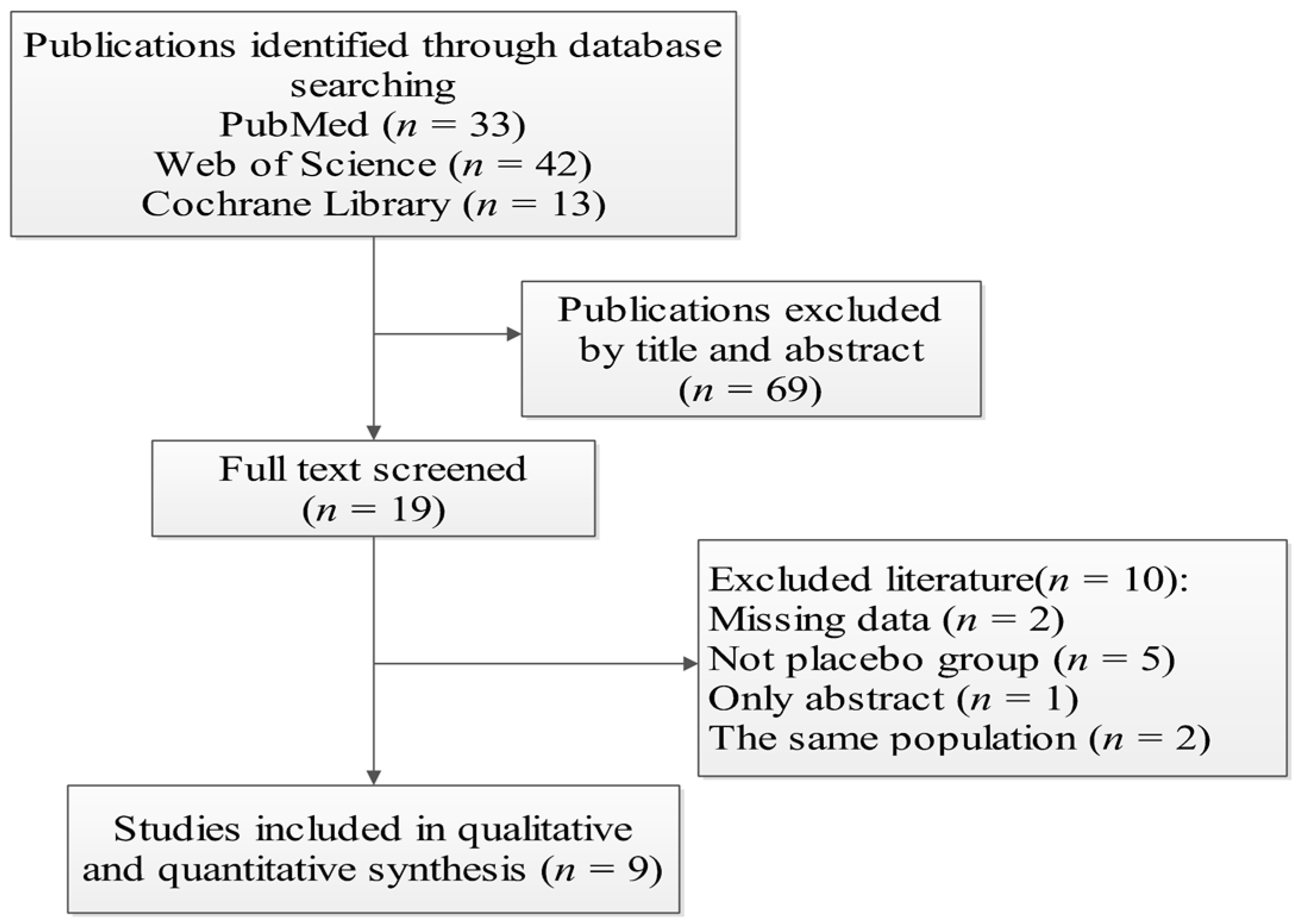


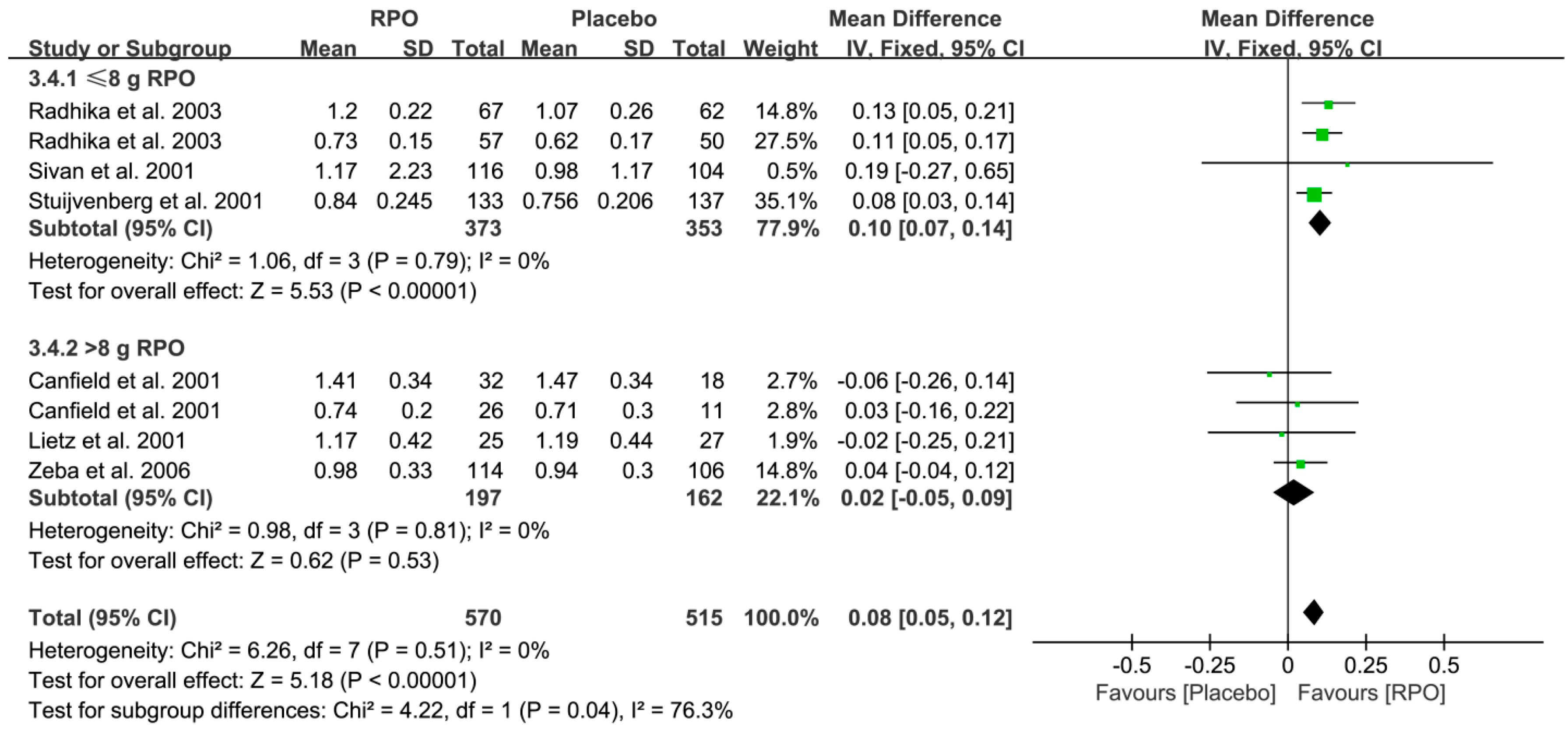
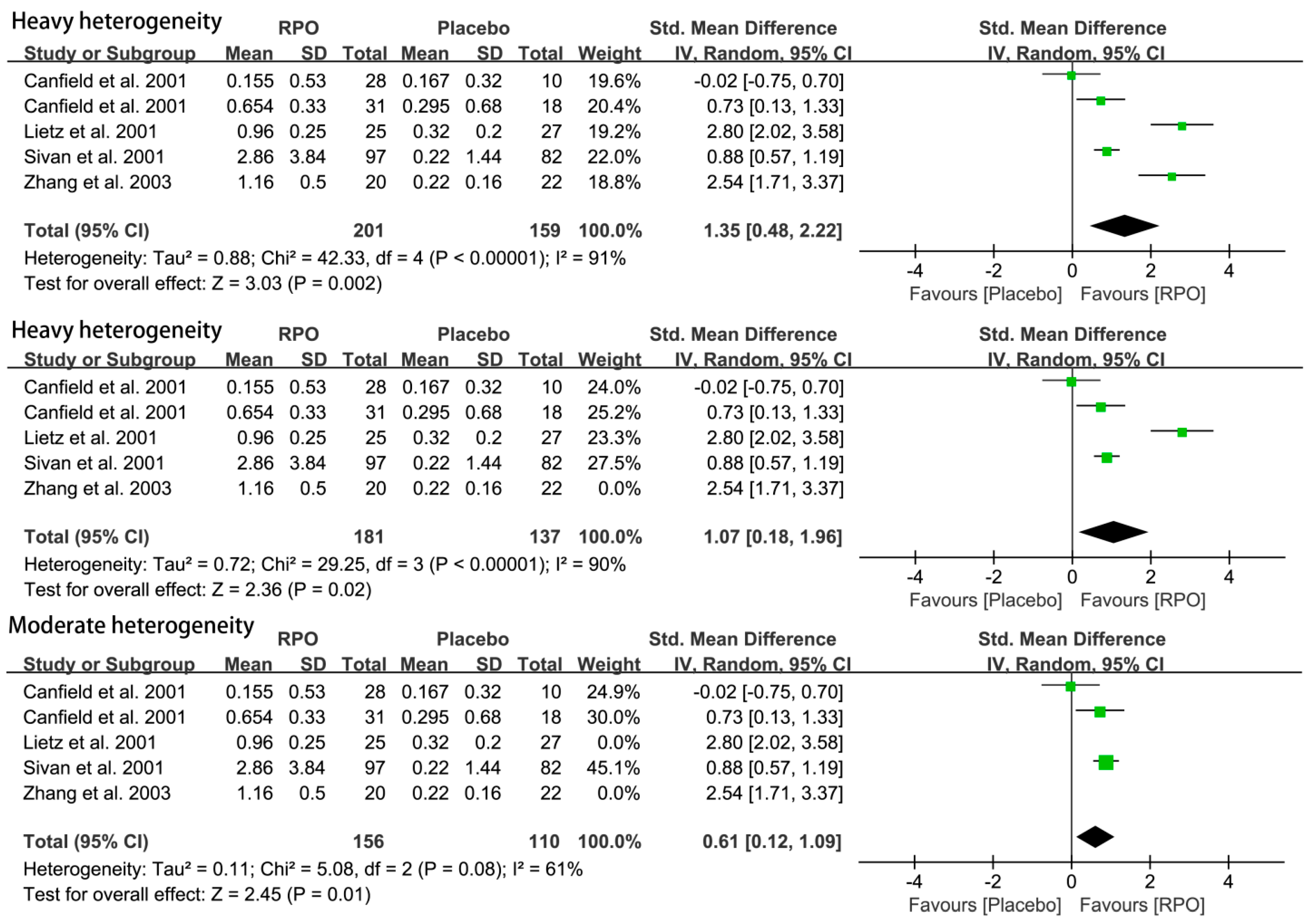
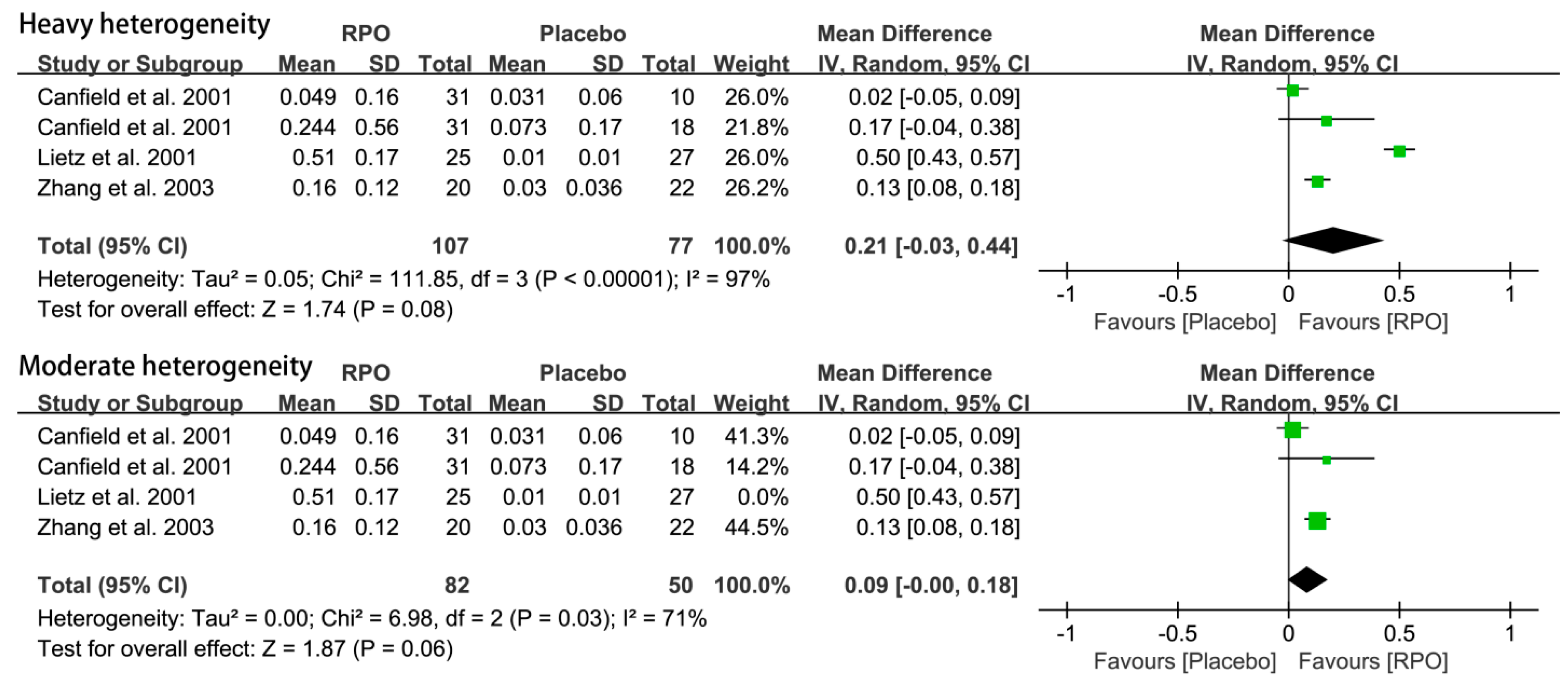
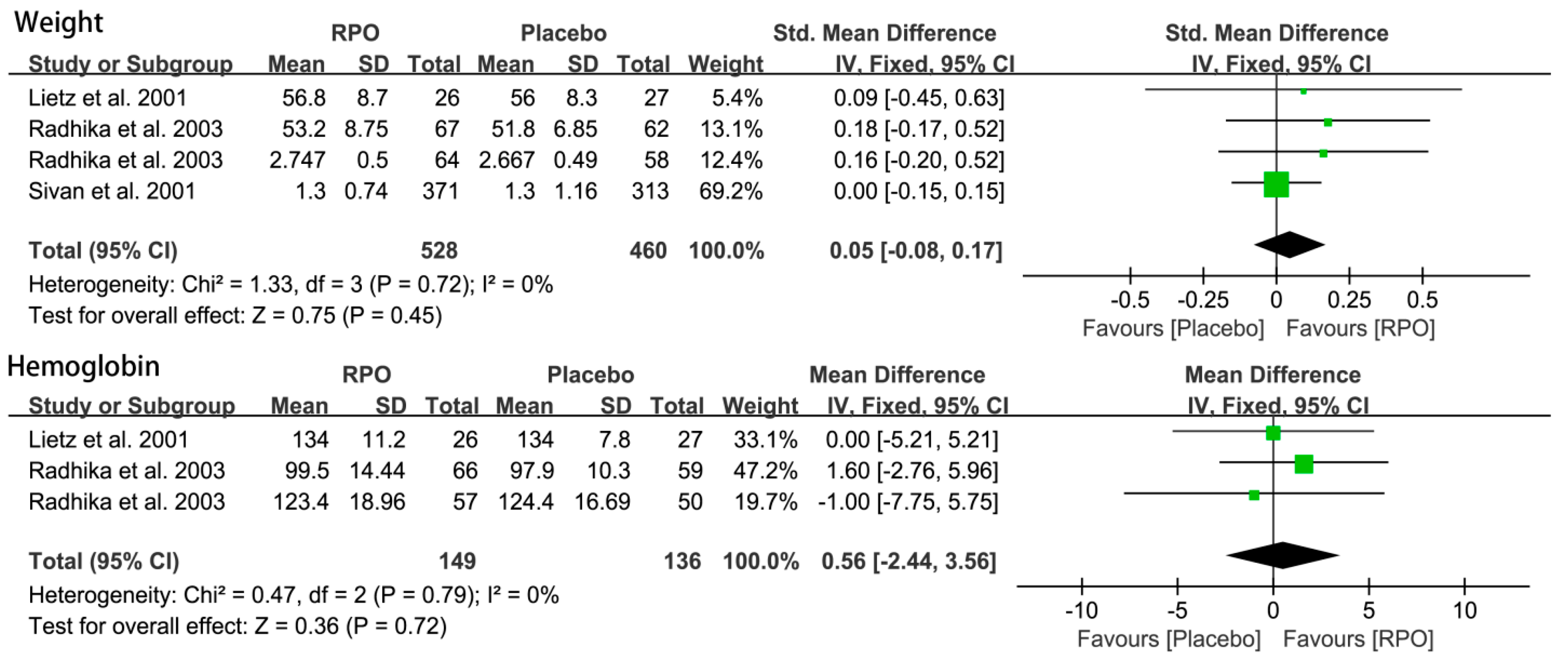
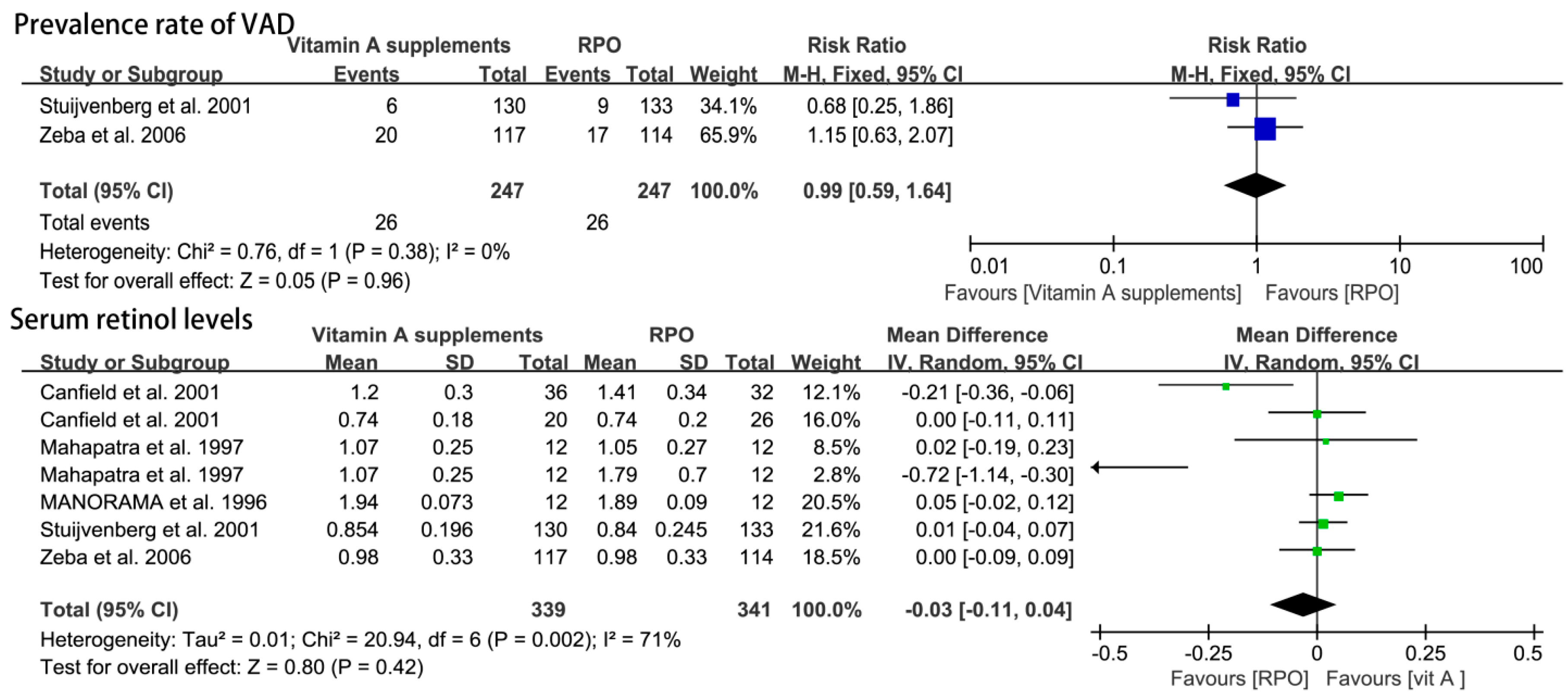
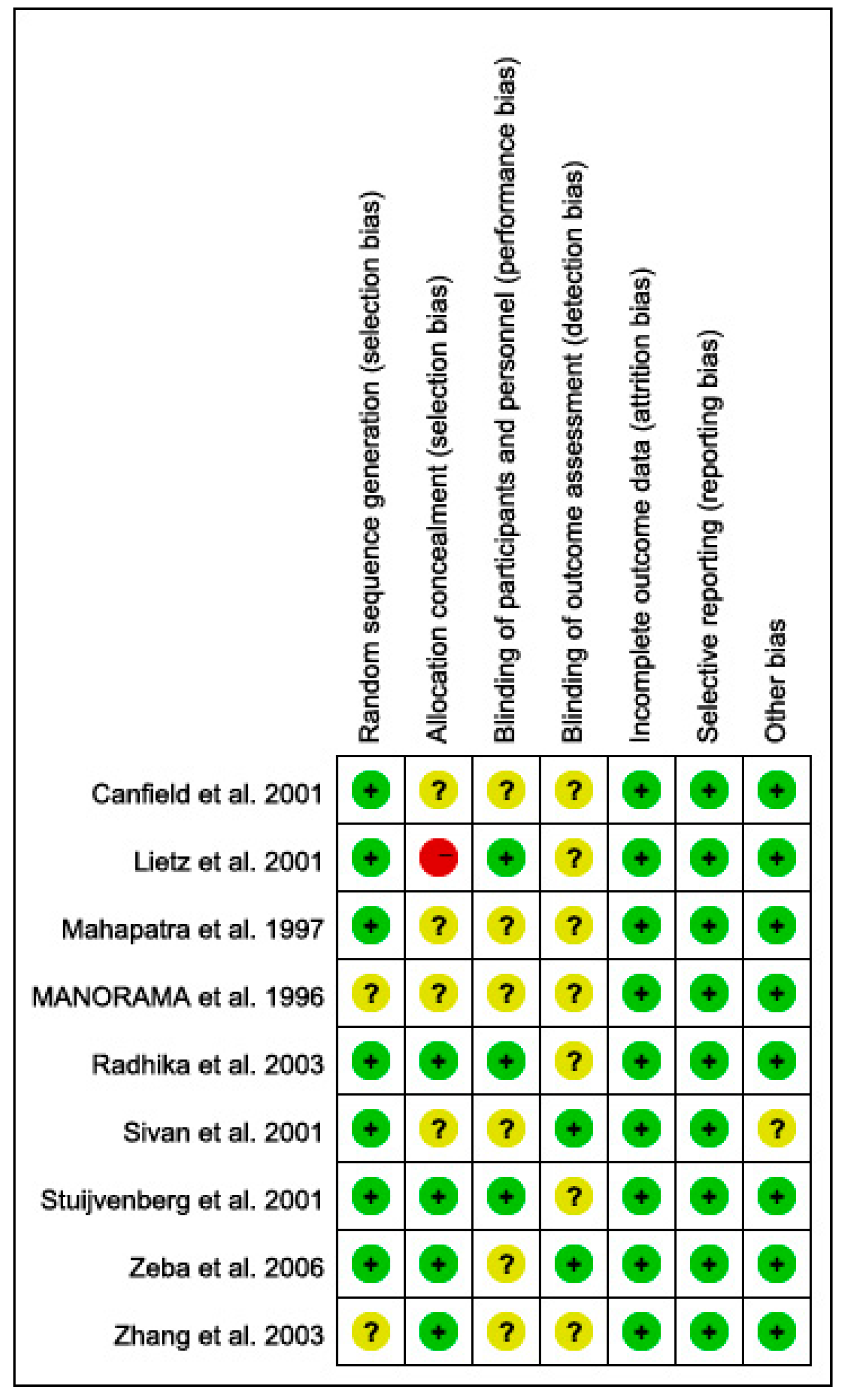
| Author’s Name, Publication Year | Country | Group | Interventions | Dosage | Population Characteristics (Age in Years/Months, Sex: Female/Male) | Baseline Vitamin A Status (μmol/L) | Follow-Up |
|---|---|---|---|---|---|---|---|
| Sivan et al. [26] 2001 | India | Placebo group | Use of 5 mL groundnut oil for preparation of the noon meal as usual | 0 | Preschool children (--) | -- (8.6% Bitot’s spots) 1 | 40 weeks |
| RPO group | Incorporation of 5 mL RPO into the noon meal after mild seasoning | Provided 5 mL RPO | Preschool children (--) | -- (8.8% Bitot’s spots) | |||
| Stuijvenberg et al. [15] 2001 | South Africa | Placebo group | A placebo biscuit | 0 | School children (8.7 ± 2.0 years; 48.9:51.1) | 0.721 ± 0.203 (52.6% VAD) 3 | 12 weeks |
| RPO group | A biscuit with RPO | Provided 1.23 mg β-carotene | School children (8.6 ± 2.1 years; 51.9:48.1) | 0.728 ± 0.245 (56.4% VAD) | |||
| Vitamin A supplement group | A biscuit with synthetic β-carotene | Provided 1.17 mg β-carotene | School children (8.8 ± 2.0 years; 44.6:55.4) | 0.714 ± 0.210 (58.5% VAD) | |||
| MANORAMA et al. [27] 1996 | Not mentioned | RPO group | Supplemented with β-carotene in the form of Suji halwa made with 8 g RPO | Provided 8 g RPO | School children (7.6 ± 1.07 years; 1:1) | 0.86 ± 0.45 (66.7% conjunctival xerosis and 33.3% Bitot’s spots) | 60 days |
| Vitamin A supplement group | Supplemented with 600 μg of vitamin A | Provided 600 μg of vitamin A | school children (7.7 ± 1.00 years; 1:1) | 0.74 ± 0.31 (50% conjunctival xerosis and 25.0% Bitot’s spots) | |||
| Lietz et al. [18] 2001 | Tanzania | Placebo group | Sunflower oil for use in household food preparations | 0 | Pregnancy women (26.4 ± 6.8 years; 1:0) | 0.91 ± 0.48 (38.7% low vitamin A status 2 and 25% VAD) | 24 weeks |
| RPO group | Received 12 g RPO for use in household food preparations | Provided 12 g RPO | Pregnant women (27.2 ± 5.9 years; 1:0) | 0.96 ± 0.29 (38.7% low vitamin A status and 25% VAD) | |||
| Canfield et al. [28] 2001 | Honduras | Placebo group | Received breakfast with placebo capsules | 0 | Lactating mothers (26.0 ± 6.5 years; 1:0) | 1.42 ± 0.34 | 10 days |
| RPO group | Received breakfast mixed with 90 mL RPO. | Provided 90 mL RPO ≈ 90 mg β-carotene | Lactating mothers (26.0 ± 6.5 years; 1:0) | 1.34 ± 0.23 | |||
| Vitamin A supplement group | Received 90 mg β-carotene capsules | 90 mg β-carotene capsules | Lactating mothers (26.0 ± 6.5 years; 1:0) | 1.28 ± 0.3 | |||
| Placebo group | Breast feeding (mother received placebo capsules) | -- | Infants (7.0 ± 4.0 months; --) | 0.67 ± 0.26 8.8% severe VAD 2 and approximately 50% VAD. | |||
| RPO group | Breast feeding (mother received RPO) | -- | Infants (7.0 ± 4.0 months; --) | 0.64 ± 0.15 (Consistent with the above) | |||
| Vitamin A supplement group | Breast feeding (mother received β-carotene capsules) | -- | Infants (7.0 ± 4.0 months; --) | 0.71 ± 0.27 (Consistent with the above) | |||
| Radhika et al. [16] 2003 | India | Placebo group | Received 8 mL groundnut oil | 0 | Pregnant women (21.6 ± 2.78 years; 1:0) | 0.93 ± 0.23 4 | 8 weeks |
| RPO group | Received 8 mL RPO | Provided 8 mL RPO ≈ 2173 to 2307 μg β-carotene/day | Pregnant women (21.5 ± 2.74 years; 1:0) | 0.90 ± 0.19 | |||
| Placebo group | Breast feeding (mother received groundnut oil) | -- | Newborn (--) | -- | |||
| RPO group | Breast feeding (mother received RPO) | -- | Newborn (--) | -- | |||
| Mahapatra et al. [29] 1997 | India | RPO group I | Given 4 g RPO in Besan laddu | Provided 25,000 IU of vitamin A | Children (--) | 0.53 ± 0.12 92% VAD | 15 days |
| RPO group II | Given 8 g RPO in Besan laddu | Provided 50,000 IU of vitamin A | Children (--) | 0.60 ± 0.13 83% VAD | |||
| Vitamin A supplement group | Given a mega dose of vitamin A. | Provided 50,000 IU | Children (--) | 0.56 ± 0.11 92% VAD | |||
| Zeba et al. [30] 2006 | Burkina Faso | Placebo group | With only the regular school lunch | 0 | Pupils (94 ± 20 months; 43:57) | 0.96 ± 0.36 (23.6% VAD) | 7 months |
| RPO group | Received 15 mL RPO in individual meals 3 times a week | Provided 15 mL RPO | Pupils (102 ± 22 months; 49:51) | 0.82 ± 0.30 (40.4% VAD) | |||
| Vitamin A supplement group | Received a single vitamin A capsule (60 mg) | Provided 60 mg VA capsule | Pupils (101 ± 20 months; 49:51) | 0.77 ± 0.28 (46.1% VAD) | |||
| Zhang et al. [31] 2003 | China | RPO group | Received RPO | -- | Men (18–32; 0:1) | 1.48 ± 0.29 | 42 days |
| Placebo group | Received soybean oil | 0 | Men (18–29; 0:1) | 1.30 ± 0.23 |
© 2017 by the authors. Licensee MDPI, Basel, Switzerland. This article is an open access article distributed under the terms and conditions of the Creative Commons Attribution (CC BY) license (http://creativecommons.org/licenses/by/4.0/).
Share and Cite
Dong, S.; Xia, H.; Wang, F.; Sun, G. The Effect of Red Palm Oil on Vitamin A Deficiency: A Meta-Analysis of Randomized Controlled Trials. Nutrients 2017, 9, 1281. https://doi.org/10.3390/nu9121281
Dong S, Xia H, Wang F, Sun G. The Effect of Red Palm Oil on Vitamin A Deficiency: A Meta-Analysis of Randomized Controlled Trials. Nutrients. 2017; 9(12):1281. https://doi.org/10.3390/nu9121281
Chicago/Turabian StyleDong, Shunan, Hui Xia, Feng Wang, and Guiju Sun. 2017. "The Effect of Red Palm Oil on Vitamin A Deficiency: A Meta-Analysis of Randomized Controlled Trials" Nutrients 9, no. 12: 1281. https://doi.org/10.3390/nu9121281
APA StyleDong, S., Xia, H., Wang, F., & Sun, G. (2017). The Effect of Red Palm Oil on Vitamin A Deficiency: A Meta-Analysis of Randomized Controlled Trials. Nutrients, 9(12), 1281. https://doi.org/10.3390/nu9121281





